How the Do-it-Yourself can Skip the Mechanic & Use an OBD-II Scanner for Massive Savings
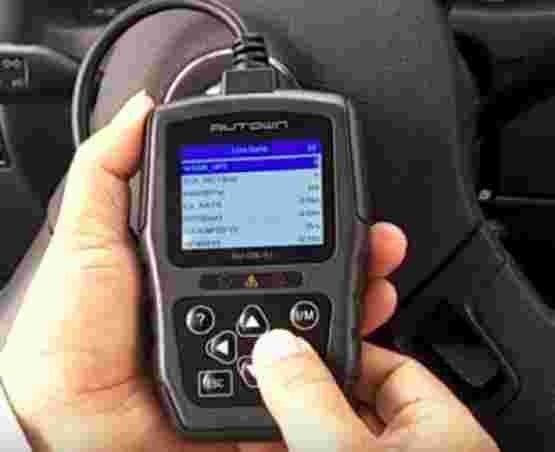
Free Car Insurance Comparison
Compare Quotes From Top Companies and Save
Secured with SHA-256 Encryption
Joel Ohman
Executive Chairman
Joel Ohman is the CEO of a private equity-backed digital media company. He is a published author, angel investor, and serial entrepreneur who has a passion for creating new things, from books to businesses. He has previously served as the founder and resident CFP® of a national insurance agency, Real Time Health Quotes. He has an MBA from the University of South Florida. Joel has been mentione...
Executive Chairman
UPDATED: Jun 24, 2022
It’s all about you. We want to help you make the right coverage choices.
Advertiser Disclosure: We strive to help you make confident auto insurance decisions. Comparison shopping should be easy. We are not affiliated with any one auto insurance provider and cannot guarantee quotes from any single provider. Our partnerships don’t influence our content. Our opinions are our own. To compare quotes from many different companies please enter your ZIP code on this page to use the free quote tool. The more quotes you compare, the more chances to save.
UPDATED: Jun 24, 2022
It’s all about you. We want to help you make the right coverage choices.
Advertiser Disclosure: We strive to help you make confident auto insurance decisions. Comparison shopping should be easy. We are not affiliated with any one auto insurance provider and cannot guarantee quotes from any single provider. Our partnerships don’t influence our content. Our opinions are our own. To compare quotes from many different companies please enter your ZIP code on this page to use the free quote tool. The more quotes you compare, the more chances to save.
On This Page
The On-board Diagnostic (OBD) is a tool that can save a Do-It-Yourself mechanic a ton of money.
I am going to explain what they are, how to operate one, and how they will help you save in the long run.
The OBD-II scanner is an automotive diagnostic tool which enables you to diagnose, interpret codes and repair your vehicle without spending a lot for mechanic repair bills.
As a seasoned mechanic myself I recommend every DIY mechanic get an OBD-II scanner for massive savings in time & money.
In my area, mechanics can charge upwards of $90 per hour.
A good OBD-II scan tool should be able to read and retrieve all the information stored in the vehicle’s computer system.

Note: Illustrated above is an OBD-II universal scan tool which can fit any vehicle manufactured after 1996. Also known as an OBD2 scanner, these tools are great since you can isolate the problem by getting a set of codes from the scanner.
What’s OBD2? Does My Car Have It?
According to federal law, all vehicles manufactured since 1996 are required to have OBD II or second generation standards.
In order to be meet this required standard, your vehicle’s on-board computer should be able to monitor and perform diagnostics test on the vehicle emissions.
This will ensure that your vehicle is operating at an allowable emission level set by the Federal Test Procedure (FTP).
All passenger vehicles manufactured since 1996 are OBD II compliant.
These vehicles usually have a 16-pin diagnostic connector or data link connector (DLC) which enables you to connect the scan tool with vehicle’s computer memory.
Some of the vehicles made in 1994 and 1995 have connectors, but that does not mean they are OBD II compliant.
Below I have listed a few scan tools.
I have used all of them and each are very good.
If you are a beginner I recommend the cheaper tools.
While the professional can use the more expensive ones.
| Scan Tool | Price | Airbag/SRS | Erase Codes | Consumer Rating |
|---|---|---|---|---|
| Autel AL619 | $120.00 | Yes | Yes | 4.1 / 5 |
| Actron CP9670 | $109.00 | Yes | Yes | 4.1 / 5 |
| Ancel AD310 | $35.00 | Yes | Yes | 4.6 / 5 |
| Autel AutoLink AL319 | $34.00 | Yes | Yes | 4.2 / 5 |
| Kiwitata | $39.00 | No | Yes | 3.8 / 5 |
How Do I Use An OBD-II Scanner?
Most OBD-II scan tools are available at local auto-part stores and many online stores.
Some of them are Bluetooth enabled, and you have to download an app to interpret the data after purchasing the automotive diagnostic tool.
I have an article of Bluetooth enabled scan tools here.
Always ensure you get a code reader which displays the fault codes as well as the explanations directly on your device. These diagnostic trouble codes will assist you in getting to the root of the problem.
First, locate the diagnostic link connector (DLC) in your car.
It is usually a 16 pin triangular shaped connector which commonly located underneath the dash along the steering column in most vehicles.
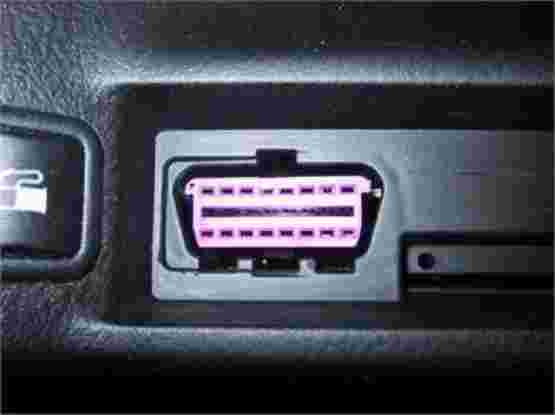
Note: Illustrated above is the diagnostic link connector or DLC in a vehicle. You may have to look around a bit in your own vehicle to find it. Most them are under the dash near the steering column.
If you have a difficulty locating the DLC search online using the car’s model and the year or you can check the owner’s manual.
Insert the code reader or the scan tool connector into the DLC.
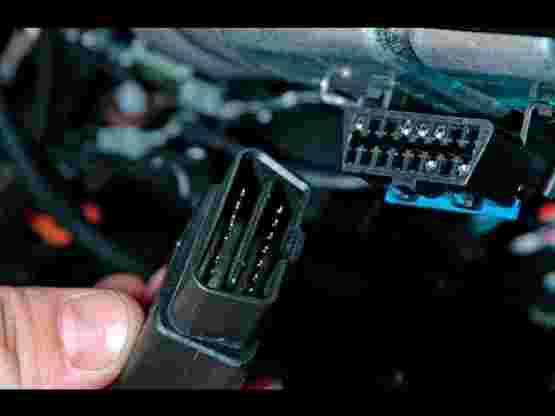
Note: Make sure your vehicle is “off”. Take your OBD-2 Scanner and put into the DLC as illustrated above. The male and female ends are shaped a particular way so there is only one way to make them fit.
Turn on the ignition without starting the car engine, and you will see a message like “searching for protocol” and “establishing a link” on the screen.
This means the scanner is communicating with the vehicle’s computer memory and establishing a data transmission link.
If the screen stays blank, turn off and on the ignition key or try to jiggle the connector to see if it establishes a contact between the DLC connector pins and the scanner tool.
If it doesn’t work, try to check if the cigar lighter works.
This is because most OBD2 scanners use the cigar circuit when providing voltage to the DLC.
Some scanners require you to input your vehicle’s information such as VIN and model of your car.
You might also be needed to specify the type of your engine, but this process usually varies depending on the scan tool.
Always go for an automotive diagnostic tool which can automatically obtain this information.
After the scanner finishes booting up, go to the menu and select “Codes” or “Trouble Codes” to open the code menu.
Depending on the scan tool and the model of your vehicle, you will be present with functions such as Transmission, Powertrain, Airbag, ABS among others.
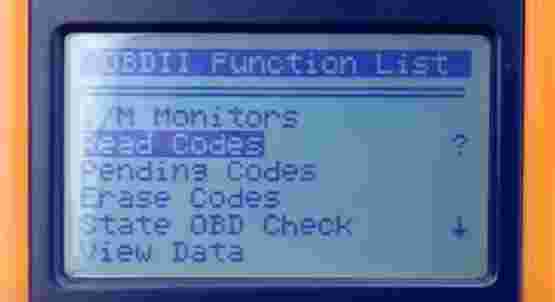
Note: Illustrated are the function codes on a scanner. You can scroll up or down and view the problem or pending codes. After you get your codes you have to find out what they mean. This is easy so don’t worry.
When you select these options, it will lead you to more types of codes.
The most common codes are pending codes and active codes.
Active codes are the live codes which turn the engine light on.
However, when the light engine is off it doesn’t necessarily mean the problem has been solved.
Sometimes it indicates that the code setting conditions has not occurred for more than two operations.
The pending codes mean the OBD-II monitory system has failed at least once in its operation.
Each code usually starts with a letter which designates a type of code in the system.
For instance, the letter P represents powertrain issues such as transmission, B represents body issues such as air bags and C indicates issues such as ABS.
Also, familiarize yourself with all universal codes in order to interpret the codes well.
Below I have provide a list of common error codes and what they mean.
Common OBD-II Repair Codes
| Code | Description | Symptoms* |
|---|---|---|
| P0128 | Coolant Thermostat (Coolant Temperature Below Thermostat) | Check Engine Light on, Vehicle may not shift into the highest gear at freeway speed, Decrease in fuel economy. |
| P0171 | System Too Lean | Performance problems, such as a lack of power on acceleration and some "coughing" or misfiring, The vehicle may have trouble idling, especially when warm or when sitting at a stoplight. |
| P0174 | System Too Lean (Bank 2) | Lack of power on acceleration and some "coughing" or misfiring, trouble idling, especially when warm or when sitting at a stoplight. |
| P0300 | Engine temperature has not increased and/or reached the correct level within a specified amount of time after engine startup. | Rough running, hesitation, and/or jerking when accelerating. |
| P0401 | Insufficient EGR Flow | Pinging on acceleration, when the engine is under load or when driving the vehicle at higher speeds. |
| P0420 | Catalyst System Efficiency Below Threshold | Some performance problems noticed by the driver such as a lack of power from a restricted and/or damaged Catalytic Converter. |
| P0440 | Evaporative System Malfunction, Large Leak | May be a noticeable fuel odor caused by the release of fuel vapors. |
| P0442 | Evaporative Emission System Leak Detected (small leak) | Noticeable fuel odor caused by the release of vapors. |
| P0455 | Evaporative Emission System Leak Detected (large leak) | Fuel odor |
| P0456 | Evaporative Emission System Leak Detected (very small leak) | Check engine light on. |
How Far Can I DIY?
Note that not all codes can be fixed easily using the scanner tool.
There is an expensive automotive diagnostic tool which can support special functions.
At the end of the day you may need a car part which needs to be replace by a mechanic.
The important thing is this.
Even with a $35 OBD-II scanner you can isolate the issue much easier.
Making it less likely you will be ripped off at the mechanic’s shop.
When is it time for you get a mechanic involved rather doing your own DIY project?
Even a cheap OBD scanner can save you hundreds of dollars. Once you get familiar with it you are armed with the knowledge of many mechanics.
That is going to be based on your own judgement. Sometimes the OBD-II scanner may isolate the issue to a bad fuse.
And of course you can do that yourself.
I have learned this particularly with beginners.
Most beginners do not know how to isolate the vehicle issue.
Especially for today’s modern cars with computers.
When I showed a few newbies how to use an OBD-II they couldn’t believe how easy it was!
Every single one of them said “That’s it?”
I said “Yep”.
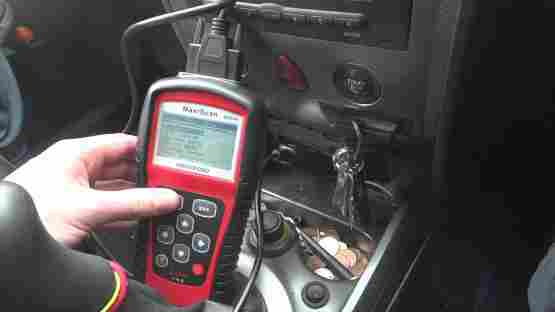
Image courtesy of YouTube.
Note: Illustrated above is a beginner using an OBD-II scanner to find car problems through codes presented on the screen. After, you have to look up the codes which can be found easily online. Notice in the image the Diagnostic Link Connector (DLC) is located on the center console area.
If you have a little working experience and the right tools, when you are armed with an OBD-II scanner, you pretty much can topple about anything.
Most important, the scanner can keep you from being ripped off by an unscrupulous mechanic.
Unfortunately if you are without an OBD tool you may have to visit a mechanic.
Again, this came become very costly.
And the mechanic has most people by the balls when this happens.
Get an OBD-II Scanner Now
You can get an OBD now and starting saving.
To me I think it is common sense.
If you already know what the issue is with your car you tell a mechanic to fix it.
This is what an OBD will do for you.
If you don’t have one then…you know how the story goes.
Unless your are mechanically inclined, you should be careful not to waste a lot of time, money, or energy trying to fix a problem by yourself.
Mechanics call this “Throwing parts at a problem and hoping it gets fixed.”
This can wind up costing more than expected.
Lastly consider your safety.
Some vehicular issues require the use of a mechanic.
Changing the timing belt in some cars requires taking the whole engine out.
Then you have to time it.
Most DIY at home mechanics are not equipped to do this.
If you think you may injure yourself call a friend or a mechanic to help you fix the problem.
Or least have the “buddy system” for safety.
How can OBD-II Scanners Save You Thousands of Dollars?
People often take their cars to a mechanic and get overcharged over a small fault that could have been easily fixed.
Below I have created table of the labor and repair costs by state.
The reason for this is to show you that a $35.00 scanner is worth it.
Especially when you see repair bills listed below.
The labor costs range from $148 to $160 depending on the state you reside in.
There is a search feature so you can find the cost for your state.
| State | Avg. Labor Cost | Avg. Parts Cost | Avg. Repair Cost (Parts & Labor) |
|---|---|---|---|
| Connecticut | $160.93 | $250.52 | $411.45 |
| District of Columbia | $164.62 | $246.36 | $410.98 |
| Rhode Island | $159.39 | $246.44 | $405.83 |
| Georgia | $168.56 | $227.81 | $396.37 |
| Maryland | $162.03 | $230.96 | $392.99 |
| Montana | $167.90 | $220.41 | $388.31 |
| Utah | $164.16 | $223.79 | $387.95 |
| Delaware | $164.38 | $223.36 | $387.74 |
| Colorado | $169.20 | $218.04 | $387.24 |
| Tennessee | $168.67 | $217.23 | $385.90 |
| Alabama | $171.23 | $212.39 | $383.62 |
| New Jersey | $160.36 | $223.14 | $383.50 |
| Mississippi | $174.61 | $207.40 | $382.01 |
| North Carolina | $163.03 | $218.29 | $381.32 |
| Nevada | $162.63 | $218.30 | $380.93 |
| Idaho | $168.30 | $212.01 | $380.31 |
| Kentucky | $165.70 | $213.01 | $378.71 |
| Alaska | $169.45 | $209.04 | $378.49 |
| Arizona | $163.89 | $213.87 | $377.76 |
| Washington | $161.43 | $215.06 | $376.49 |
| Virginia | $160.90 | $215.55 | $376.45 |
| Florida | $162.44 | $213.95 | $376.39 |
| Massachusetts | $156.91 | $218.64 | $375.55 |
| Oregon | $159.69 | $214.79 | $374.48 |
| Louisiana | $166.15 | $207.97 | $374.12 |
| South Carolina | $164.31 | $209.77 | $374.08 |
| Arkansas | $167.04 | $206.66 | $373.70 |
| New Mexico | $162.98 | $210.15 | $373.14 |
| West Virginia | $160.88 | $212.06 | $372.94 |
| Pennsylvania | $160.78 | $212.16 | $372.94 |
| Missouri | $164.99 | $204.32 | $369.31 |
| Oklahoma | $168.76 | $200.05 | $368.81 |
| New York | $157.51 | $211.18 | $368.69 |
| Texas | $162.45 | $205.39 | $367.84 |
| Illinois | $159.65 | $206.57 | $366.22 |
| New Hampshire | $156.09 | $210.05 | $366.14 |
| California | $158.74 | $206.71 | $365.45 |
| Iowa | $159.63 | $205.56 | $365.19 |
| Kansas | $160.98 | $203.34 | $364.32 |
| Nebraska | $165.61 | $198.67 | $364.28 |
| Minnesota | $160.41 | $202.71 | $363.12 |
| Wyoming | $170.69 | $190.74 | $361.43 |
| Indiana | $161.39 | $198.72 | $360.11 |
| South Dakota | $166.99 | $192.82 | $359.81 |
| Vermont | $141.13 | $218.58 | $359.71 |
| North Dakota | $159.41 | $195.09 | $354.50 |
| Ohio | $156.93 | $192.25 | $349.18 |
| Hawaii | $148.11 | $198.83 | $346.94 |
| Wisconsin | $155.56 | $191.25 | $346.81 |
| Maine | $152.24 | $191.36 | $343.60 |
| Michigan | $160.63 | $182.77 | $343.40 |
The Bottom Line
The automotive diagnostic tool allows you to diagnose and research a problem right at your home without visiting a mechanic.
This will help you save on diagnostic costs or repair bills.
If you have a few mechanic skills in handling minor repairs, the scanner tool will be a huge asset and will save you a lot of money.
Though some services require you to visit a professional mechanic, having an OBD II will allow you to know the nature of the problem and figure out if it needs an experienced person.
Also, with an OBD2 scanner, you will be able to isolate the issue. Then, you can order parts online and fix the problem by yourself.
If the problem persists you will be in a position to make an informed decision.
Free Auto Insurance Comparison
Enter your ZIP code below to view companies that have cheap auto insurance rates.
Secured with SHA-256 Encryption
Joel Ohman
Executive Chairman
Joel Ohman is the CEO of a private equity-backed digital media company. He is a published author, angel investor, and serial entrepreneur who has a passion for creating new things, from books to businesses. He has previously served as the founder and resident CFP® of a national insurance agency, Real Time Health Quotes. He has an MBA from the University of South Florida. Joel has been mentione...
Executive Chairman
UPDATED: Jun 24, 2022
It’s all about you. We want to help you make the right coverage choices.
Advertiser Disclosure: We strive to help you make confident auto insurance decisions. Comparison shopping should be easy. We are not affiliated with any one auto insurance provider and cannot guarantee quotes from any single provider. Our partnerships don’t influence our content. Our opinions are our own. To compare quotes from many different companies please enter your ZIP code on this page to use the free quote tool. The more quotes you compare, the more chances to save.